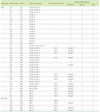Abstract
The aim of this study was to evaluate the performances of MicroScan (Siemens Healthcare, USA) and Phoenix (Becton Dickinson Diagnostic Systems, USA) automated systems for the detection of extended-spectrum β-lactamase (ESBL)-producing Escherichia coli and Klebsiella pneumoniae. ESBL-producers were detected from 18 E. coli strains and 26 K. pneumoniae strains using MicroScan, Phoenix, and double-disk synergy test (DDST). The ESBL types were determined by PCR direct sequencing. ESBL genes were detected in 38 (86.4%) of the 44 test strains. The sensitivities of MicroScan, Phoenix, and DDST were 94.6%, 79%, and 89.5%, respectively. Both MicroScan and Phoenix provided acceptable results for the examination of clinical isolates.
Figures and Tables
References
1. Ko SY, Chung JW, Song AJ, Yoon NS, Sung H, Kim MN. Evaluation of the MicroScan NegCombo panel Type 44 for detection of extended-spectrum beta-lactamase among clinical isolates of Escherichia coli, Klebsiella species, and Proteus mirabilis. Korean J Lab Med. 2009. 29:35–40.

2. Li XM, Jang SJ, Bae IK, Park G, Kim YS, Shin JH, et al. Frequency of extended-spectrum β-lactamase (ESBL) and AmpC β-lactamase genes in Escherichia coli and Klebsiella pneumoniae over a three-year period in a university hospital in Korea. Korean J Lab Med. 2010. 30:616–623.

3. Jarlier V, Nicolas MH, Fournier G, Philippon A. Extended broad-spectrum beta-lactamases conferring transferable resistance to newer beta-lactam agents in Enterobacteriaceae: hospital prevalence and susceptibility patterns. Rev Infect Dis. 1988. 10:867–878.

4. Wiegand I, Geiss HK, Mack D, Stürenburg E, Seifert H. Detection of extended-spectrum beta-lactamases among Enterobacteriaceae by use of semiautomated microbiology systems and manual detection procedures. J Clin Microbiol. 2007. 45:1167–1174.

5. Snyder JW, Munier GK, Johnson CL. Direct comparison of the BD phoenix system with the MicroScan WalkAway system for identification and antimicrobial susceptibility testing of Enterobacteriaceae and nonfermentative gram-negative organisms. J Clin Microbiol. 2008. 46:2327–2333.

6. Leverstein-van Hall MA, Fluit AC, Paauw A, Box AT, Brisse S, Verhoef J. Evaluation of the Etest ESBL and the BD Phoenix, VITEK 1, and VITEK 2 automated instruments for detection of extended-spectrum beta-lactamases in multiresistant Escherichia coli and Klebsiella spp. J Clin Microbiol. 2002. 40:3703–3711.





 PDF
PDF ePub
ePub Citation
Citation Print
Print



 XML Download
XML Download